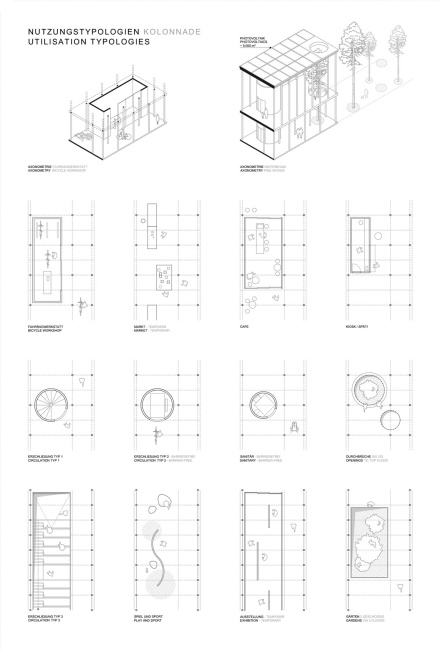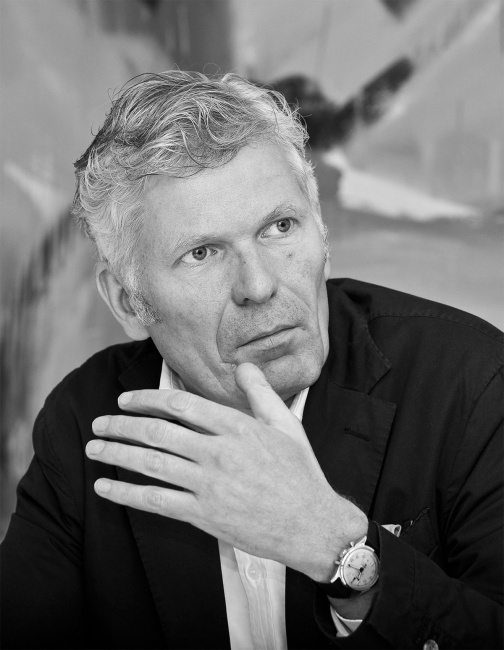Kreuzberg: Lindenstraße
Jan Kleihues and Heike Hanada
A Colonnade
The eastern side of Lindenstrasse in Kreuzberg is relatively clearly defined, however the same cannot be said for the western side, especially in the south. The light footprint of this colonnade - the “Lindenkolonnade” - is broken up by trees, columns with climbing plants, and with raised trellises. Verdant, diverse planting seeks to restore the street to the human scale. The structure has various unique features, with an emphasis on the entrance, exit, and each transitory point between the rows of columns. Positioned near the sports field next to the Jewish Museum, this raised, pillared canopy surrounded by pine trees offers protection from sun and rain. The different levels host a series of marketplaces and workshops, accompanied by a small neighbourhood library. The walkways facilitate an interaction between people and the surrounding nature. The Lindenkolonnade represents a new city that is optimistically facing up to the questions posed by the future.

Existing street space
Opposite Daniel Libeskind’s Jewish Museum in Kreuzberg was the former wholesale flower market. Newly added buildings have attempted to match Lindenstrasse’s layout, however Maximilian Meisse’s photograph captures the fragmentary nature of the street architecture.

© Jan Kleihues und Heike Hanada
Lindenstrasse in Southern Friedrichstadt
The area of Southern Friedrichstadt is still marked by the destruction of the Second World War, and marred by the division of the city. New building policies in the 1960s and 1970s exacerbated this discordance. The once balanced baroque grid of the city was now impossible to restore, even with the International Building Exhibition (IBA) in 1987. Lindenstrasse runs right through this inconstant setting.
Site plan 1:500
The colonnade stretches from north to south, from the wide section of Lindenstrasse opposite the Axel-Springer-tower, all the way to the peripheral buildings of Mehringplatz. The opening in the north is marked by a small local library, while in the south a so-called “curiosity”, a small urban viewpoint, offers a prospect towards Landwehrkanal.


Spatial intervention
The Lindenkolonnade is designed to improve the area with minimal interference, by introducing classical colonnades to add definition within the space of the barren streetscape and for local amenities. Elongated roof panels on top of the colonnade can hold solar cells to generate renewable energy. The columns and trellises are arranged with dense climbing plants alongside newly planted groves, not only improving the microclimate but also the overall quality of the neighbourhood. The intermixing of public and semi-public spaces through vertical gardens should provide lasting impact and pay tribute to the name Lindenstrasse – the street of lime trees.
The street and the square
The elegantly designed colonnade appears almost floating above the street, held up by closely arranged round steel supports. It opens up before the W. Michael Blumenthal Academy opposite the Jewish Museum. Here, a square with towering lime trees provides shade and structure, creating an organic interplay between architecture and flora.

Jan Kleihues and Heike Hanada
Jan Kleihues worked with Peter Eisenman, Daniel Libeskind and Rafael Moneo before setting up his own office in 1992. In 1996, he and Josef Paul Kleihues founded Kleihues + Kleihues together with Norbert Hensel. After various guest professorships, he has been teaching at the Potsdam School of Architecture since 2011.
Heike Hanada founded “hh_laboratory of art and architecture” in Weimar in 2007. She was awarded first prize for the competition design for the extension of the “Asplund Library” in Stockholm. In 2019, she received the Thuringian Architecture Prize for the newly opened Bauhaus Museum Weimar. She has been teaching at TU Dortmund University since 2018.

